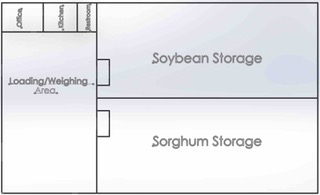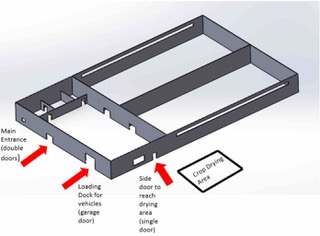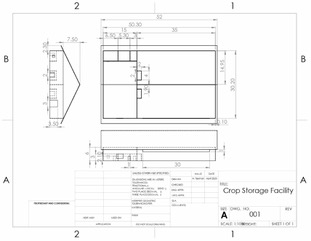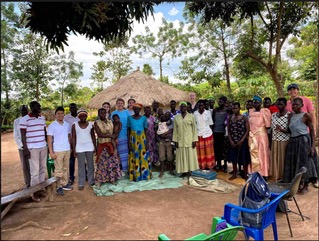Ugandan Crop Storage
Overview
Agriculture employs nearly 70% of the workforce in Uganda, but many farmers lose up to 40% of their harvest due to improper food storage practices. Uganda has a very tropical climate and crops oftentimes are lost to exposure at high humidity and temperature levels, given the harvest is currently stored in the residences of the farmers — small mud huts. Given the current storage situation, fire, mold and pest infestation, and theft appear to be the most significant concern.
Our task is to design a stakeholder approved communal crop storage facility. The ability to store the crops would allow the farmers the opportunity to sell their harvest at a low supply time in the market, yielding much higher profit margins. This new cycle of storing and increasing profit stimulates the local economy and allows for new community opportunities, such as children receiving formal education.
Our client is Global Livingston Institute, a non-profit organization based in Denver that focuses on East African development projects. Their motto is “Listen, Think, Act” and thus take community research and stakeholder engagement into consideration before moving forward. Given the country’s instability and trauma in previous years, Global Livingston has partnered with other local organizations to rebuild rural communities. These organizations both work together to ensure successful and sustainable models for development, and discovered the need for the crop storage facility.
The engineering challenge is to design a communal crop storage facility able to store two different grains with their respective optimal temperature and humidity levels, with limited access to modern technology and resources.
Team Members - The Crop Docs
- Chris Linan
- Abby Tiesman
- Jess Horii
- Joson Ralph
- Laila Amery
- Sydney Fesenmeyer
The Client
- Global Livingston Institute (GLI)
- Children of Peace – Uganda (CPU)
Acknowledgements
Thank you to Global Livingston Institute for connecting with Mines and making this project possible. Thank you to Children of Peace Uganda for working with us to make your vision a design, and helping provide us with so much of the information on the project. Thank you both for hosting us in Uganda and providing us with an unforgettable experience. Thank you to our project advisors Dr. Elizabeth Reddy and Dr. Alina Handorean for your provided guidance and feedback. Thank you to Dr. Reza Hedayat, Dr. Joseph Crocker, Samuel Engola Okello, and Dr. Paulo Tabares for providing technical expertise. Thank you to all the friends and family for seeing the value in our project and helping make our trip to Uganda possible.Thank you to the departments of Humanitarian Engineering, Humanities Arts & Social Science, and the International Office for generous contributions.
Elevator Pitch
Click here to see the video the Crop Docs made including a summary of the project as well as clips from a concert we were able to attend celebrating GLI’s 10th anniversary. Not only were we able to learn about the logistics that goes into the construction of a facility such as this, we learned about the culture of Uganda and what makes it such a special place.
Design Approach
This project’s objective is to design a facility for both sorghum and soybeans with the potential to store other crops as needed. This facility should be easily accessible, secure, user friendly, and resistant to pests and moisture. Based on preliminary information from the local community, we are to design the facility with very low or no electricity options as well as low water usage. One of the main challenges in this design is the limited access to reliable technology with the developing state of the country. One initial idea was to create a simple in ground storage cellar, but this would not allow for the proper storing conditions of each grain. After individual grain condition research, we discovered we needed to design a warehouse like building with simple methods for adjusting temperature and humidity as needed.
Given the limited resources available, research was conducted to determine the most efficient solar powered system to include in our design implementation. These solar panel manufacturers are located throughout Uganda, allowing for easier purchasing and maintenance options. Adding low levels of power to the facility will significantly increase the facility’s usability and capability.
Additional concepts were selected for garage doors and facility windows, as well as loading bay areas. These factors encompass the total functionality of the storage and receiving area, from physical structure to internal offices and break areas.
We were allowed the incredible opportunity to travel to Uganda to conduct field research and engage with stakeholders directly. Visiting the country was a critical component in our design approach because one of the most important aspects of community design projects, particularly in third world countries, is receiving direct stakeholder input and wants. Community outreach is extremely important to ensure a successful and sustainable project, as this facility needs to meet their needs and match their lifestyle.
This trip was a valuable opportunity to get a full understanding of who will be using our facility and the immense need for improved storage options. After much communication with our client and stakeholders, we were able to explore their differing perspectives. The main difference is that Children of Peace, who is leading the project, was planning for a single large storage facility on land that they own in town, while the farmers, who will be using the facility to store their crops, did not trust having their crops so far away from them and wanted many smaller storage facilities in their communities a couple miles outside of town. The farmers cannot build the storage facility on their own, but if CPU builds it on their land in town and the farmers don’t use it, then it was a pointless project. We used the knowledge we gathered during the trip to make a recommendation for a single storage facility, but only if CPU can gain the trust of the farmers. The main takeaway from our experience was the various local community issues that factor into the project.



Unexpected Design Challenges
- Communication between the stakeholders and CPU – the farming groups surrounding Lira (the stakeholders) want smaller facilities closer to home to eliminate the need for transportation as well as being able to secure the facility on their own. CPU, however, wants to manage the land that they already own and have a bigger facility that more groups can utilize at once.
- Communication between our team and our clients – there is a 10 hour time difference as well as somewhat of a language barrier between us and some of the people we are trying to contact, and sometimes it’s difficult to get the most out of the time we have with them on video chats. Conveying large amounts of information through emails is also difficult.
- Differences in cultural construction norms – although this wasn’t necessarily unexpected, it was a challenge none-the-less. The practices and materials used that we had originally planned on needed adjusted according to what there is access to; for example, we had initially incorporated concrete masonry blocks in our design only to realize that wouldn’t be a feasible option and the local bricks would be a more convenient and cost-efficient material.
Design Solution
The final design we have come up with fulfills the initial requirement of designing a crop storage facility with the capacity to store crops for approximately 450 farmers in Lira, Uganda. The solution we have come to will be able to hold more than the original goal of 200,000 kg of sorghum and soybeans, the primary crops that are being grown by these groups. After talking to local farmers in Lira, we learned that it would be beneficial to incorporate extra storage for other crops such as maize that weren’t initially accounted for. The design of the facility meets the requirement of being hermetic and able to keep out pests and unwanted moisture, and the conditions in the separate rooms can be adjusted depending on what crop is inside. It will require a transportation system to be set in place in order to get the crops from the farmers and to the facility.
In terms of the layout of the structure, there will be two large storage rooms, a loading area, an office, small kitchen, and washroom. To keep the storage rooms hermetic and cool, there will be no direct sunlight entering the storage spaces as well as the implementation of two doors in succession between these rooms as the loading area to limit the exterior environment from entering. The ceiling height of the storage areas will be roughly 6 meters tall to optimize vertical storage capacity. Windows will be built into the storage rooms for natural lighting, however an overhang of the roof will assist with keeping out direct sunlight. The windows will be aluminum-framed being that they won’t need to open, and come from a local store. The windows in the main loading area and office area will be operational and obtained elsewhere. The loading area will have access to the office and the washroom while the kitchen would only be accessible from the office. The loading area will have an open feel to it by having a large window in between the office and the loading area which will provide viewing access for the worker in the office to the operations happening outside. The height of the walls surrounding the office, kitchen, and washroom will be about 3 meters tall, making them shorter than the height of the storage rooms. The loading area will be accessible by 3 doors: one garage door for loading/unloading, a set of double doors near the office for people, and another door on the opposite side of the office that can be used to access the outside crop drying area. The entire structure will sit on a concrete foundation that will help keep the facility airtight and pest free.
The structure itself will be mostly made out of clay bricks, which are locally found in Lira, Uganda and more affordable than the concrete option. The roof will be the same height around all of the interior to maximize the simplicity of the design. The roof will be double-pitched with metal panels to minimize the accumulation of water during periods of heavy rainfall. These panels are also lighter than concrete and easier to install. During periods of precipitation, the rainfall will be guided through a gutter system which will eventually lead water to a retention pond. This pond water can then be recycled throughout the water system of the facility.
To supply power to the facility, we plan to have several adjustable solar panels just outside of the structure. These solar panels would have the ability of providing electricity to the facility for various purposes. The solar panels are planned to be roughly 2 m off the ground and have the ability to rotate for optimal sunlight intake. There will also be an external water storage tank that will collect rainwater adjacent to the facility. Runoff will be captured in the structure’s gutter system which will then transport it to a retention pond.
Security of the facility was a major concern expressed in the design process. The structure will be surrounded by a brick wall which will have razor wire on the top. In addition, there will be a guard post located at the entrance of the facility to regulate traffic coming in and out. There will also be security lights outside the facility that will be on throughout the course of the night.
Next Steps
Due to recent events, our goals for the project have shifted to cataloging all of the information we have accumulated over the past six months. If the project were to get passed on to others interested, we hope that they would be able to use the research we have collected to finalize a design and work with GLI and CPU to actually implement the project. The main concept for the design is pretty established, but there are many details that can still be improved. Some aspects that still need improvement are the systems used for cooling and humidity control, and choosing final products for solar panels and a water detention pond. We recommend that the new group try to travel to Lira, Uganda, and continue building relationships with the farmer groups and learning about the situation in the country. This team next year should continue researching this concept, as well as exploring other options like smaller facilities closer to farmer groups. We feel that we have completed a lot of the preliminary research, but there are still different interests between the clients and the stakeholders, so we suggest a future group continues evaluating options. There are many obstacles, such as security and transportation, that should be further considered.

